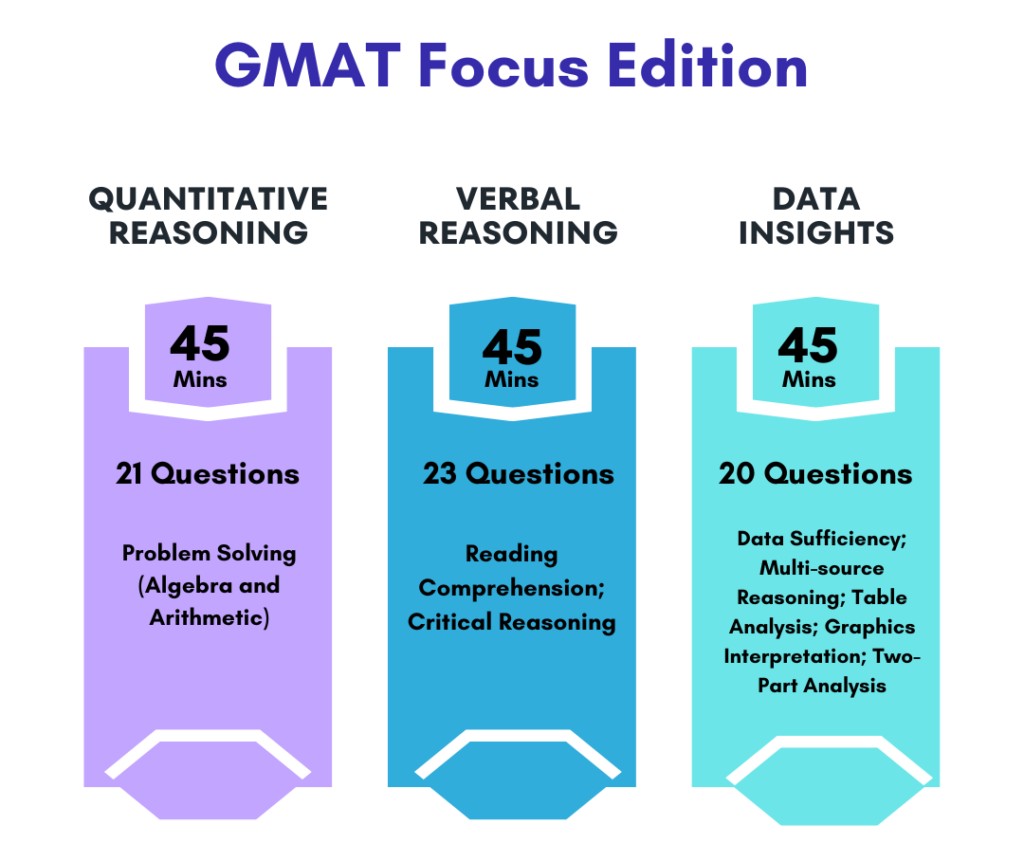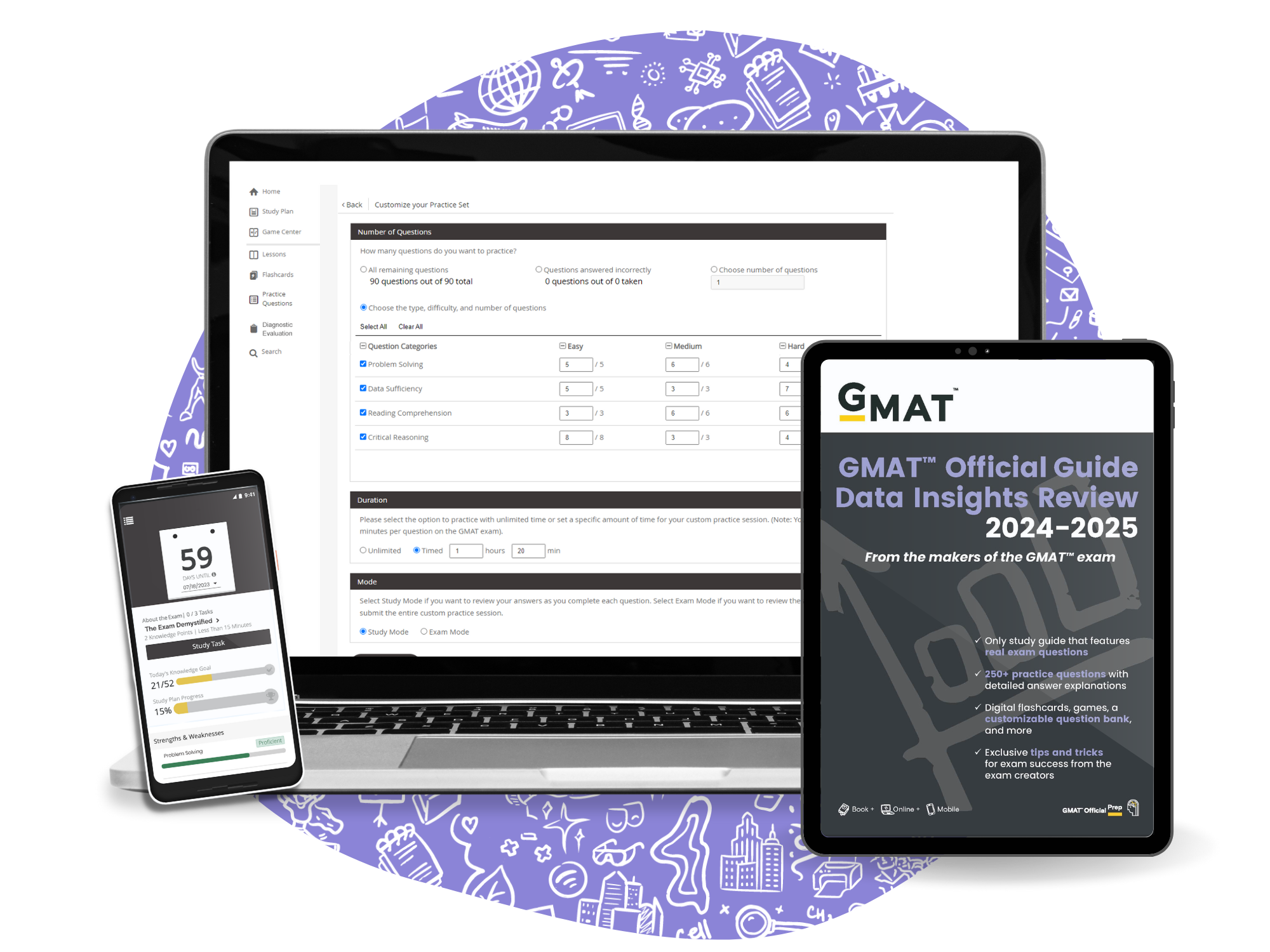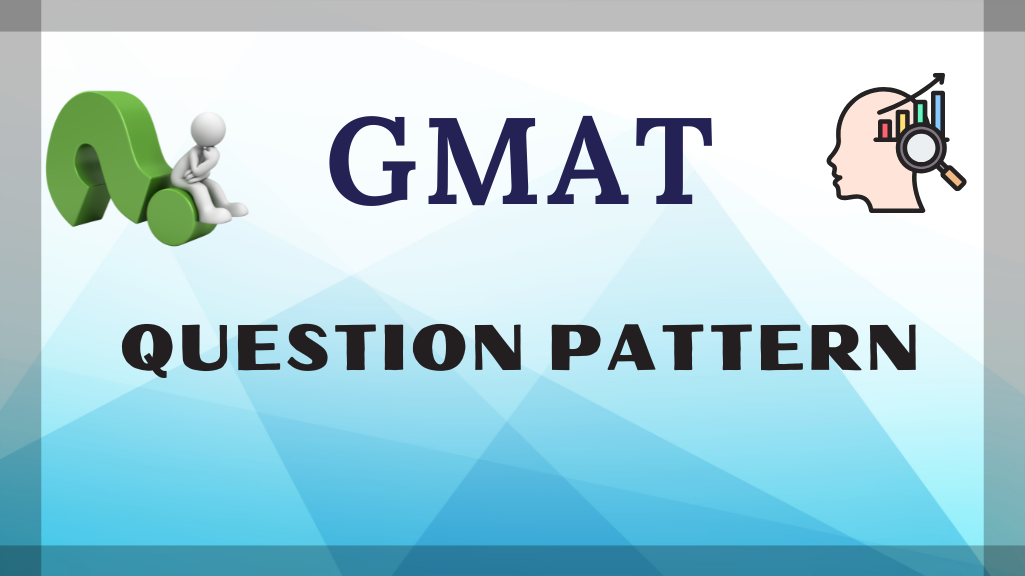The GMAT has had a major revamp with the new Focus Edition, now the standard test for business school hopefuls. This updated version includes three main sections: Quantitative Reasoning, Verbal Reasoning, and Data Insights, all packed into a 2-hour, 15-minute exam (plus an optional 10-minute break). One of the biggest changes? No more Analytical Writing Assessment (AWA) and no separate Integrated Reasoning (IR) section. Instead, the Data Insights section now combines elements of the old IR with Data Sufficiency questions—highlighting the growing importance of data skills in business.
The test is still computer-adaptive, meaning it adjusts question difficulty based on your performance. A cool new feature lets you review and edit up to three answers per section, giving test-takers a bit more flexibility. Overall, the GMAT Focus Edition is a sleeker, more modern take on the exam, zeroing in on the skills that really matter in today’s business world—especially data analysis.
GMAT question pattern
A solid grasp of the GMAT question pattern is crucial for anyone aiming to ace this exam. Understanding the format helps test-takers create focused study plans and develop smart strategies to boost their performance on test day.
This report breaks down the GMAT Focus Edition, covering:
✅ The structure of the exam
✅ Question types in each section
✅ Key topics tested
✅ Time limits and pacing
It also explores the big changes in the transition to the Focus Edition, ensuring prospective test-takers know exactly what to expect. With this insight, candidates can fine-tune their prep strategies and improve their chances of hitting their target scores.
GMAT Exam Structure
Overview of the Three Sections
The GMAT Focus Edition is structured around three distinct sections, each designed to evaluate specific skills crucial for success in graduate management programs. These sections are Quantitative Reasoning, Verbal Reasoning, and Data Insights. Each of these sections is allotted a duration of 45 minutes. The Quantitative Reasoning section comprises 21 questions, focusing on mathematical problem-solving. The Verbal Reasoning section includes 23 questions, assessing critical reasoning and reading comprehension abilities. The Data Insights section contains 20 questions, evaluating data literacy and analytical skills. The consistent time allocation across all sections suggests equal importance placed on these core skill areas in the overall assessment. Notably, the Verbal Reasoning section contains the highest number of questions, which could indicate a slightly greater emphasis on communication and analytical reading proficiencies.
Total Exam Duration and the Optional Break
The total duration of the GMAT Focus Edition is 2 hours and 15 minutes. In addition to the testing time, candidates have the option to take one 10-minute break during the exam. This represents a significant reduction in the overall exam time compared to the classic GMAT format, potentially offering a more focused and less mentally taxing experience for test-takers. The availability of a single optional break necessitates careful consideration by candidates to determine the most strategic timing for its use, balancing the need for rest with the time constraints of the exam.
The Ability to Select the Section Order
A significant feature of the GMAT Focus Edition is the flexibility it offers in allowing test-takers to choose the order in which they complete the three sections. This personalization option enables individuals to tailor their testing experience to their strengths and preferences. For instance, a candidate might opt to begin with their strongest section to build confidence or tackle a potentially more challenging section when their mental energy is at its peak. To leverage this feature effectively, it is advisable for test-takers to experiment with different section orders during their preparation to identify the strategy that best optimizes their performance.
Table 1: GMAT Focus Edition Structure
| GMAT Focus Test Section | Number of Questions | Time Allotted |
|---|---|---|
| Quantitative Reasoning | 21 | 45 Minutes |
| Verbal Reasoning | 23 | 45 Minutes |
| Data Insights | 20 | 45 Minutes |

Quantitative Reasoning Section
Number of Questions and Time Allotted
The Quantitative Reasoning section of the GMAT Focus Edition presents candidates with 21 questions that must be answered within a 45-minute timeframe . This time allocation translates to an average of slightly over two minutes per question, underscoring the importance of developing efficient problem-solving techniques and maintaining a brisk pace throughout the section.
Question Types: Problem-Solving
The question type featured exclusively in the Quantitative Reasoning section of the GMAT Focus Edition is Problem Solving. These questions are presented in a multiple-choice format, requiring test-takers to select the correct answer from five options. This represents a notable departure from the classic GMAT, which included Data Sufficiency questions in the Quantitative section. This shift necessitates a change in focus for candidates preparing for this section, emphasizing the mastery of problem-solving strategies within the domains of arithmetic and algebra.
Topics Covered: Arithmetic and Algebra
The content assessed in the Quantitative Reasoning section primarily encompasses topics within Arithmetic and Algebra. Arithmetic topics include areas such as fractions, decimals, percentages, ratios, number properties, and basic statistics. Algebra covers concepts like equations, inequalities, functions, and exponents. The focus on these fundamental mathematical concepts, relevant to business and management contexts, suggests that the section aims to evaluate the practical application of these skills in analytical scenarios. While some resources might mention geometry in the context of GMAT Quantitative Reasoning, the Focus Edition has largely eliminated geometry-related questions, with the exception of coordinate plane geometry, which is considered under the umbrella of algebra. This reduction in scope allows candidates to concentrate their preparation efforts more effectively on arithmetic and algebraic principles.
Absence of Geometry Questions in the Focus Edition
As previously mentioned, geometry questions have been largely removed from the Quantitative Reasoning section of the GMAT Focus Edition. This exclusion simplifies the preparation process for this section, enabling test-takers to dedicate their study time to mastering the concepts and problem-solving techniques within arithmetic and algebra.

Verbal Reasoning Section
Number of Questions and Time Allotted
The Verbal Reasoning section of the GMAT Focus Edition consists of 23 questions that must be completed within a 45-minute time limit . Similar to the Quantitative Reasoning section, this time allocation demands efficient reading and analytical processing to address each question effectively within the given timeframe.
Question Types: Reading Comprehension and Critical Reasoning
The Verbal Reasoning section in the GMAT Focus Edition features two primary question types: Reading Comprehension (RC) and Critical Reasoning (CR). This structure marks another significant change from the classic GMAT, which also included Sentence Correction questions in the Verbal section. The removal of Sentence Correction shifts the focus of this section entirely toward evaluating comprehension and logical reasoning abilities.
Skills Assessed: Comprehension, Critical/Analytical Thinking, and Inference
The Verbal Reasoning section is designed to assess a range of skills essential for effective communication and analytical thought. These include the ability to comprehend written material, think critically and analytically, and make logical inferences. Both Reading Comprehension and Critical Reasoning questions necessitate active engagement with the text and the capacity to process complex information efficiently. Critical Reasoning questions specifically evaluate the ability to identify underlying assumptions in arguments, strengthen or weaken arguments, and draw sound conclusions based on the provided information. Reading Comprehension questions, on the other hand, assess the test-takers skill in extracting key information, understanding the author's main purpose and tone, and making inferences that are supported by the text but not explicitly stated.
Removal of Sentence Correction in the Focus Edition
As previously noted, Sentence Correction questions are no longer part of the Verbal Reasoning section in the GMAT Focus Edition. This change implies that preparation for the Verbal section should now prioritize the development of effective reading strategies and robust logical reasoning skills, rather than focusing on grammatical rules and sentence structure.

Data Insights Section
Number of Questions and Time Allotted
The Data Insights section of the GMAT Focus Edition presents candidates with 20 questions to be completed within a 45-minute time frame. This section has the fewest number of questions among the three, yet it is allocated the same amount of time as the other sections. This might suggest that the questions in this section are generally more complex or require a more substantial amount of time for analysis and response.
Question Types
The Data Insights section features five distinct question types: Data Sufficiency (DS), Multi-Source Reasoning (MSR), Table Analysis (TA), Graphics Interpretation (GI), and Two-Part Analysis (TPA). This section represents a significant evolution from the classic GMAT, as it integrates question types from the former Integrated Reasoning section and also includes Data Sufficiency questions, which were previously part of the Quantitative Reasoning section. This integration underscores the heightened emphasis on data analysis skills in the GMAT Focus Edition. The variety of question formats, requiring the analysis of text, tables, graphs, and information from multiple sources, demands a diverse and adaptable skillset from test-takers. Notably, Data Sufficiency questions within this section might take on a different character, potentially incorporating more logical reasoning and applied scenarios rather than focusing solely on mathematical concepts.
Skills Assessed: Data Analysis, Interpretation, and Critical Thinking
The Data Insights section is specifically designed to evaluate a test-taker's abilities in data analysis, interpretation, and critical thinking. This includes the capacity to analyze and interpret data presented in various formats, draw logical conclusions from the information, and make well-informed decisions based on the analysis. Success in this section requires the ability to synthesize information from multiple formats and sources, a skill that is increasingly crucial in today's data-driven business environment. Furthermore, effectively tackling the questions in this section often necessitates a blend of both quantitative and verbal reasoning skills.
Availability of an On-Screen Calculator
A notable feature of the Data Insights section is the availability of an on-screen calculator, which can be used by test-takers while working on the questions. This is the only section of the GMAT Focus Edition where a calculator is provided. The inclusion of this tool suggests that some of the questions in this section might involve more complex calculations compared to those in the Quantitative Reasoning section, where calculators are not permitted.
Time Management on the GMAT
Effective time management is a critical factor for success on the GMAT Focus Edition. Candidates must pace themselves appropriately across all three sections to ensure they can attempt all questions within the allocated time. Developing strategies for time allocation within each 45-minute section is essential. It is generally advisable to avoid spending an excessive amount of time on any single question. If a question proves particularly challenging, it might be more prudent to make an educated guess and move on to ensure sufficient time for the remaining questions. The introduction of the ability to review and edit up to three answers per section offers a degree of flexibility in time management. Test-takers can revisit questions they were unsure about initially, provided they have time remaining at the end of the section and have not exceeded their three-edit limit. However, this review option should not be seen as a substitute for maintaining a consistent pace throughout the section to ensure all questions are addressed.
The Adaptive Nature of the GMAT
Explanation of the Computer-Adaptive Testing (CAT) Mechanism
The GMAT Focus Edition employs a computer-adaptive testing (CAT) mechanism for its Quantitative, Verbal, and Data Insights sections. This means that the difficulty level of the questions presented to a test-taker is dynamically adjusted based on their performance on preceding questions. The test typically begins with questions of medium difficulty. If a question is answered correctly, the subsequent question is likely to be slightly more challenging, whereas an incorrect answer usually leads to an easier question. This adaptive process aims to provide a more accurate assessment of a candidate's ability level. It's important to note that this adaptive mechanism operates independently for each of the three scored sections.
How Question Difficulty Adjusts Based on Performance
As mentioned, the CAT mechanism adjusts the difficulty of questions based on a test-taker's responses. A correct answer generally results in a more difficult question, and an incorrect answer leads to an easier one. Therefore, encountering a series of more challenging questions can be an indication of strong performance within a section.
The Importance of Early Performance
Performance on the initial questions in each adaptive section is particularly significant as it sets the baseline for the difficulty level of the questions that follow and can influence the overall score. A strong start, characterized by accurate responses, is crucial for accessing higher-value, more difficult questions later in the section, potentially leading to a better overall score. However, it is important to avoid the misconception that the perceived difficulty of a question is a definitive indicator of past performance; the underlying algorithm is complex.
Recent Changes to the GMAT (Focus Edition)
Transition from the Classic GMAT to the Focus Edition
The GMAT underwent a significant transformation with the launch of the Focus Edition on November 7, 2023. The previous version of the GMAT was discontinued after January 31, 2024, making the Focus Edition the standard GMAT exam from February 1, 2024, onwards. This transition marks a new era for the GMAT, with a revised format designed to better assess the skills required in today's business landscape.
Removal of the Analytical Writing Assessment (AWA) and Integrated Reasoning (IR) Sections
One of the most notable changes in the GMAT Focus Edition is the removal of the Analytical Writing Assessment (AWA) section, which requires candidates to write an essay analyzing an argument. Additionally, the standalone Integrated Reasoning (IR) section has also been eliminated. However, the skills and question types previously found in the IR section have been integrated into the new Data Insights section. This integration signifies the increased emphasis placed on data analysis as a core competency in the revised exam. The removal of the AWA results in a shorter overall testing time and shifts the focus away from the explicit evaluation of formal essay writing skills.
Changes in the Scoring System and Total Score Range (205-805)
The GMAT Focus Edition features a new scoring system with a total score range of 205 to 805. Unlike the classic GMAT, where the Integrated Reasoning and Analytical Writing Assessment sections were scored separately and did not contribute to the overall 200-800 score, all three sections of the Focus Edition—Quantitative Reasoning, Verbal Reasoning, and Data Insights—now factor into the total score. Each of these sections is scored on a scale ranging from 60 to 90 in 1-point increments. This change reflects the equal weighting of these three skill areas in the new exam format. It is important to note that scores obtained on the GMAT Focus Edition cannot be directly compared to scores from the previous version of the exam due to these differences in the scoring scales.
The Ability to Review and Edit Up to Three Answers Per Section
A significant new feature introduced in the GMAT Focus Edition is the ability for test-takers to review and edit up to three answers within each section (Quantitative Reasoning, Verbal Reasoning, and Data Insights) before submitting it. This functionality provides a greater degree of control and flexibility during the exam, allowing candidates to revisit and potentially correct their responses within the remaining time of each section.
Emphasis on Data Analysis Skills
The GMAT Focus Edition places a notably greater emphasis on data analysis skills, as evidenced by the introduction of the Data Insights section and its contribution to the total score 1 . This shift reflects the growing importance of data literacy and analytical thinking in the business world. Consequently, preparation for the GMAT Focus Edition should prioritize the development of these skills alongside the traditional quantitative and verbal abilities.
